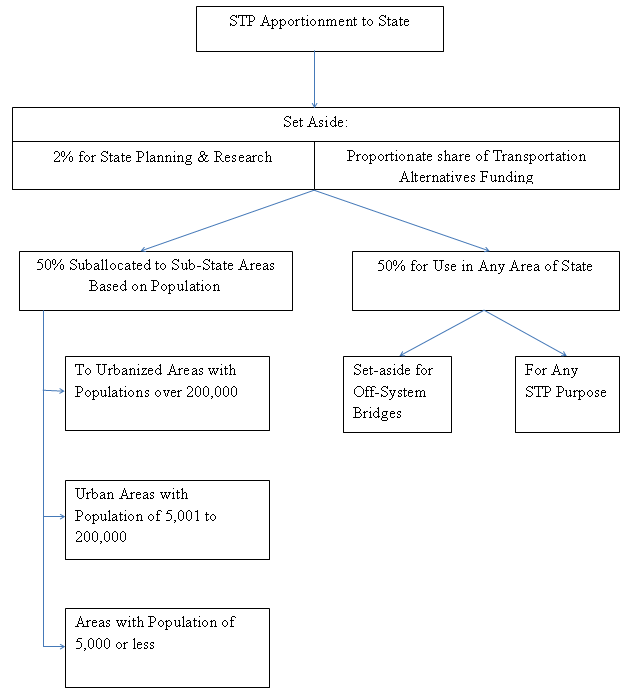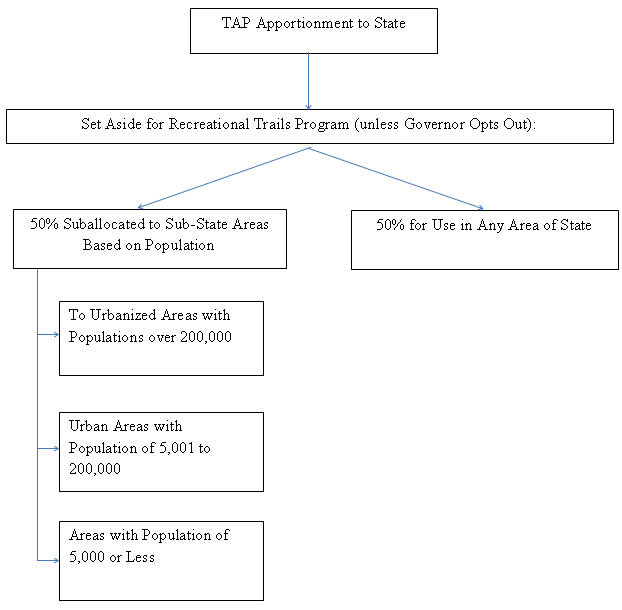U.S. Department of Transportation
Federal Highway Administration
1200 New Jersey Avenue, SE
Washington, DC 20590
202-366-4000
MAP-21 - Moving Ahead for Progress in the 21st Century
Posted 9/25/2012, Updated 1/7/2013
What is suballocation?
MAP-21 and previous transportation authorizations use the term suballocation to refer to reservations of funds apportioned to a State by formula for use in specific areas within the State. Under MAP-21, suballocation is required for a portion of each State's apportionment under the Surface Transportation Program (STP) and the Transportation Alternatives Program (TAP).
How are funds suballocated?
Surface Transportation Program [23 USC 133(d), MAP-21 §1108].-Fifty percent of a State's STP apportionment (after deducting the set-asides for State Planning and Research and the TAP) are suballocated to areas based on their relative share of the total State population with the remaining 50 percent available for use in any area of the State. The suballocated funds are divided into three categories and must be used in the areas described below [see figure 1] -
Transportation Alternatives Program [23 USC 213(c), MAP-21 § 1122].-Fifty percent of a State's TAP apportionment (after deducting the set-aside for the Recreational Trails Program) are suballocated to areas based on their relative share of the total State population with the remaining 50 percent available for use in any area of the State. The suballocation is made in the same manner as for STP funds [see figure 2].
What population data is used to calculate the suballocations? (added 1/7/2013)
The suballocations are calculated based on 2010 Census population data. The 2010 Census urban and rural population data is located on the Census Bureau web site.
The Census data divides each State into urban areas (urbanized areas and urban clusters) and rural (i.e., not included within an urban area). This data is used to determine the population breakdown used to calculate each of the three MAP-21 suballocations.
The urban area data sorted by State is found here in column E. Each State's rural population is found here in column T. The population data is broken down into the following three categories in order to make the suballocation calculations:
Please note that many urban areas cross State boundaries; these urban areas are marked with a "P" in column D of the urban area data by State spreadsheet. In such cases, the total population of the urban area, which is found here in column C, determines the appropriate suballocation distribution. However, only a State's portion of the population in the urban area, which is found in the urban area data by State spreadsheet, is used for that State's suballocation calculations.
Are the funds actually passed through to the MPOs for urbanized areas over 200,000?
The grant recipient for suballocated funds is the State highway agency to which the funds are apportioned. A State may make subgrants in accordance with State law. The key to suballocation is where the funds must be used (described above) and what entity administers and makes decisions on the use of suballocated funds (described below).
What entity makes project selection decisions when suballocated funds are used?
Generally.-The metropolitan planning and statewide and nonmetropolitan planning requirements of 23 USC 134-135 (MAP-21 §§ 1201, 1202) lay out the basic provisions related to project selection for all programs under 23 USC as follows:
STP.-In addition, there is a specific requirement [23 USC 133(d)(3), MAP-21 § 1108] that when making obligations of STP funds in an area with a population greater than 5,000 and less than 200,000, that the State must consult with the regional transportation planning organizations that represent the area if such an organization exists.
TAP.-Also, under the TAP, a State or an MPO shall develop a competitive process to allow eligible entities to submit projects for funding. [see 23 USC 213(c)(4), MAP-21 § 1122]. [See the Interim Guidance on the Transportation Alternatives Program for additional detail]
May suballocated STP and TAP funds be transferred to other Federal-aid highway programs?
A State may not transfer suballocated STP [23 USC 133(d)(1)(A)] and TAP [23 USC 213(c)(1)(A)] funds to other Federal-aid highway programs. [see 23 USC 126(b), MAP-21 § 1509].
May suballocated STP and TAP funds be transferred to FTA for administration of a transit project under chapter 53 of title 49?
Suballocated STP funds for a transit project may be transferred to FTA for administration in accordance with chapter 53 of title 49, United States Code. [see 23 USC 104(f), MAP-21 § 1105]. If it is determined that a transit project meets TAP eligibility requirements, suballocated TAP funds may be transferred to FTA for administration in accordance with chapter 53 of title 49, United States Code. [see 23 USC 104(f), MAP-21 § 1105].
Figure 1
Surface Transportation Program Suballocation

Figure 2
Transportation Alternatives Program Suballocation
